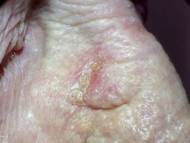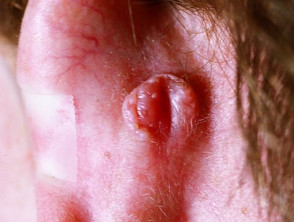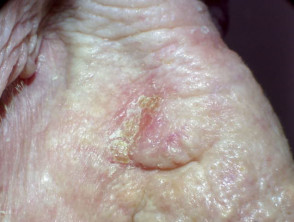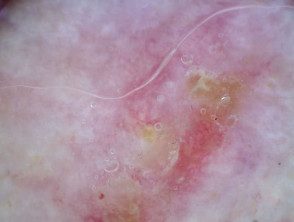What is acanthoma fissuratum?
Acanthoma fissuratum is an uncommon condition that occurs in people who wear glasses; it presents as a papule, nodule or plaque with raised edges where the spectacle frame presses on the skin.
Acanthoma means thickened skin, and fissuratum refers to fissuring, erosion or ulceration, which often occurs in the centre of the lesion. Acanthoma fissuratum has also been called granuloma fissuratum and spectacle frame granuloma, although no actual granulomas are found on histology.
Acanthoma fissuratum
Who gets acanthoma fissuratum?
Factors that are thought to contribute to the development of acanthoma fissuratum include:
- Poorly fitted spectacle frames or heavy frames
- Pre-existing skin disease at the site of the lesion
- Local anatomical abnormalities.
Similar reactions have been reported to be caused by the use of hearing aids.
What causes acanthoma fissuratum?
The most widely accepted theory is that acanthoma fissuratum develops as the result of chronic irritation due to friction and pressure at the site of contact with the glasses frame.
What are the clinical features of acanthoma fissuratum?
Acanthoma fissuratum presents as a firm flesh-coloured papule, nodule or plaque that has a central furrow dividing the lesion in half (a 'coffee bean' appearance). It is often painful, particularly if ulcerated.
The lesions are located where the glasses rest on the individual’s skin, most commonly, the lateral bridge of the nose or the retroauricular or superior auricular sulcus (behind the ear).
How is acanthoma fissuratum diagnosed?
Acanthoma fissuratum can be recognised clinically if the possibility is considered.
If a biopsy is taken or the lesion is excised, histological features observed include:
- Prominent acanthosis, mild ortho-hyperkeratosis, and hypergranulosis of the epidermis
- Proliferation of small, slightly dilated vessels in the papillary dermis, with variable patchy chronic inflammation in a background of fibrotic stroma
- Wide, blunt-ended and centrally attenuated rete ridges
- Focal areas of spongiosis and parakeratosis.
What is the differential diagnosis of acanthoma fissuratum?
Acanthoma fissuratum can be similar in appearance to basal cell carcinoma. A biopsy can be taken if there is any doubt.
What is the treatment for acanthoma fissuratum?
Acanthoma fissuratum is a benign lesion that spontaneously resolves if the source of skin irritation is removed and the skin is allowed to heal.
Ideally, the patient should stop wearing glasses for a period of time, although this is not always practical if no other options for vision correction are available.
Intralesional corticosteroid injection into the lesion can relieve symptoms.
What is the outcome for acanthoma fissuratum?
When allowed to heal without irritation from spectacles, acanthoma fissuratum will resolve without long-term scarring.
If the individual chooses to continue wearing tightly fitting glasses, it may recur.



